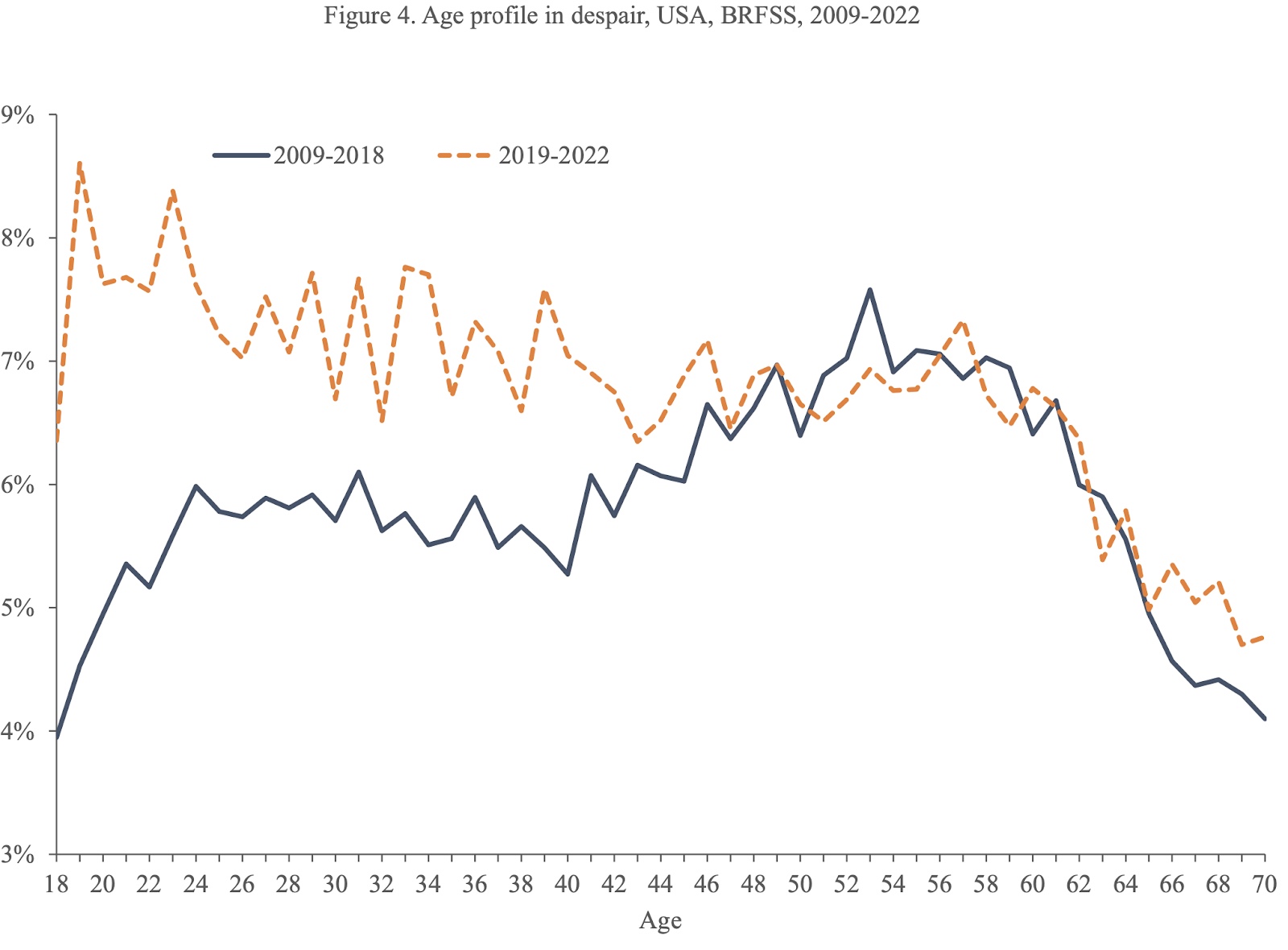This story was produced by The 74, a non-profit, independent news organization focused on education in America.
An upswell in despair among young people is changing the life cycle of human happiness in many countries, according to a new series of studies. The authors argue that the crisis in well-being among children and adolescents may be substantially driven by their increased exposure to smartphones over the last decade.
Courtesy of David Blanchflower
David Blanchflower, Dartmouth College economist
The research, led by a prominent expert in the burgeoning field of happiness economics, is attracting attention as authorities in the United States and several other countries voice louder concerns about the influence of technology on kids. Its conclusions could add to the calls for more strict regulation of their access to social media, which have already led to phone bans in classrooms and contentious hearings in Congress about the fate of TikTok.
Economist David Blanchflower’s new paper uses surveys from the past 15 years to show a pronounced increase in sadness affecting 14- to 24-year-olds.
In February, Dartmouth College economist David Blanchflower released a working paper that used survey evidence to show a pronounced increase in sadness and hopelessness over the past 15 years affecting people between the ages of 14 and 24. That trend mirrored a similar and dramatic rise in the time that young people, and especially young women, spent in front of a television, computer, smartphone, or gaming console over the same years.
In an interview, Blanchflower called the twin developments “a crisis of our kids” that would harm their ability to lead worthwhile lives and hamper social progress in the long run. While the tight correlation between rising unhappiness and the growth of screen time isn’t enough to decide the question of whether one causes the other, he added, the relationship was too obvious, and too dangerous, to ignore.
“We could fart around about causality, but the potential cost of not doing something is so much greater than the cost of doing something and being wrong.”
— David Blanchflower, Dartmouth University
“You need a variable that starts in 2011 and is especially true for women, and you get screen time,” he said. “I don’t know of anything else, so if that’s not it, what is it?”

Jean Twenge, psychologist
Blanchflower is hardly the first to offer this hypothesis. In the mid-2010s, just as American children’s declining mental health began to be noticed by both experts and the public, psychologist Jean Twenge accused smartphones of “destroying a generation” of kids. More recently, she has been joined by social psychologist and author Jonathan Haidt, whose new book, The Anxious Generation, levels a similar indictment.
Both Twenge and Haidt have loudly criticized the effects of smartphones and social media on children’s mental health.
But with the arrival of Blanchflower’s critique, one of the world’s leading economists has entered the chat. And while pointing to similar data and results, his conclusions paint a distinctly new picture of the emotional trajectory experienced by much of the world’s population. Hundreds of studies previously tracked a consistent pattern to people’s long-term moods — one in which most start off relatively happy, become somewhat less so in their 40s and 50s, and then rebound later — but those rhythms have, for the moment, been upended.

Courtesy of NYU Stern
Jonathan Haidt, psychologist
Still, not all observers are as convinced as Blanchflower that technological shocks lie at the heart of the problem. While conceding that an excess of social media very likely leads to harmful consequences, researcher and commentator Will Rinehart said it would be exceedingly difficult to identify their exact effects, let alone change them for the better.
“The technology itself brings new social opportunities and new ways of interacting with your peers,” said Rinehart, a senior fellow at the right-leaning American Enterprise Institute. “When that box is open, it’s kind of impossible to shut it again.”
The shape of happiness
Blanchflower, a labor economist who gained public recognition by accurately forecasting the 2008 recession as an advisor to the Bank of England, has spent much of his career studying the economics of happiness — essentially an inquiry into the welfare and life satisfaction of people around the world.
Such questions have often been left to psychologists, who traditionally take a broader view than social scientists of human motivation and behavior. As more economists expanded the sub-field, however, they generated new insights about the growing happiness of African Americans compared to whites and the particularly adverse reactions of women to the experience of the pandemic.
[Related: On paper, teens are thriving. In reality, they’re not]
Perhaps the most noteworthy finding has been that people tend to experience their greatest happiness in both childhood and old age, while enduring a trough during midlife. That consistent dropoff, usually coincident with the growing responsibilities of career and parenthood, is referred to as the “U-shape” of personal well-being — high on either side, low in the middle. Its reverse, a depiction of negative emotion, would be conceived as a “hump shape.”
But according to another paper, released by Blanchflower and his co-authors earlier this month, those descriptions are no longer accurate. In an analysis of over 1.4 million survey responses across 34 countries, Blanchflower and his collaborators discovered that young adults’ widely-reported increase in fear, depression, and anxiety in recent years has contorted the hump shape of unhappiness; instead, people appear to be most unhappy around age 18 and become less so as time goes on.

Blanchflower said that reports of freefalling indicators of mental health for teenagers and young adults, including increased hospitalizations for self-harm and greater suicidality, led him to check on the latest data from benchmark surveys such as the Centers for Disease Control’s Behavioral Risk Factor Surveillance System, which conducts health-related interviews with 400,000 adults every year. The results from the past half-decade were eye-opening, he recalled, and were equally present in figures from the United Kingdom as well as the United States.
Banning smartphones at schools: Research shows higher test scores, more exercise]
“I got in there early and said, ‘I’d better take a look at this because I’ve got endless research saying there’s a happiness U-shape,’” he said. “And I started to look and said, ‘Holy moly, it’s gone!’” People in their late teens and early 20s are now the most likely to report experiencing despair, with people in their late 60s and early 70s substantially less apt to say the same.
An additional overview of findings from the Global Mind Project, which polls a vast swath of international respondents, also demonstrated a steep rise in fear, anxiety, and suicidal thoughts among adults in dozens of countries (again including the U.K. and the U.S.).
COVID has often been cited as a major force playing on the anxieties of young people. But the survey responses strongly indicate that the pandemic actually accelerated pre-existing trends, Blanchflower and his co-authors noted. The sense of displacement brought on by online instruction in the early 2020s may have only intensified the same alienation triggered by online interaction in the 2010s.

Devorah Heitner/LInkedIn
Devorah Heitner, author
Devorah Heitner is a parent and author who has personally canvassed children around the country to learn how they and their peers navigate a world mediated by screens and social networks. While intermittently skeptical of the most vocal critics of smartphones and social media, including Twenge, she said many young people express a desire to limit their interactions with technology.
“Kids are very aware of their relationships with their phones,” said Heitner, whose book on the virtual lives of kids, Growing Up in Public, became a bestseller last year. “They wish they could take a break from it, or that they could get their friends to use them less.”
The ‘cost of not doing something’
Educators, parents, and politicians are increasingly open to considering restrictions on how children can engage with the internet and social media.
In Florida, Republican Gov. Ron DeSantis recently signed a law banning social media accounts for children younger than 14 and requiring 14- and 15-year-olds to obtain parental permission. Last month, the U.S. House of Representatives passed a bill that would force the sale of the Chinese-owned platform TikTok, citing concerns both about users’ data security and the app’s effects on its youngest users. (The proposal has since been tied to a comprehensive package of foreign aid that is expected to win approval in the Senate.)
Heitner said that social media companies should curb their most “manipulative” features, including location sharing, which allows users to see where their friends are at a given time. Yet she also believes that full-on bans risk curtailing some of the constructive ways that adolescents use technology. While many are bullied or harassed online, for example, others find outlets for their stress and connections with new friends.
“Many of the girls I’ve talked to are using social media in really positive ways: to stay connected to friends, to do activism, to do creative work,” Heitner said. “It really does vary.”
“Many of the girls I’ve talked to are using social media in really positive ways: to stay connected to friends, to do activism, to do creative work.”
— Devorah Heinter, author of Growing Up in Public

Courtesy of mitch.web.unc.edu
Mitch Prinstein, psychologist
Mitch Prinstein at the University of North Carolina and the chief science officer of the American Psychological Association, struck a similar note. The existing research revealed a correlation between the introduction of mass smartphone use and the decline of youth mental health, but not a firm causal connection, he argued. While some studies offered more suggestive evidence — including one experiment that paid students to deactivate Facebook, which left them happier and less polarized than before — potential contributors to the well-being crisis could also include a worsening political climate, along with the frequently circulated fears of environmental disaster and school shootings.
“We can certainly demonstrate that some features of social media are bad for kids,” Prinstein said. “They don’t fit kids’ brain development, they’re depriving kids of alternative experiences — absolutely. I just bristle at the idea of saying this is the singular cause of the youth mental health crisis.”
“We can certainly demonstrate that some features of social media are bad for kids. I just bristle at the idea of saying this is the singular cause of the youth mental health crisis.”
— Mitch Prinstein, University of North Carolina
In both of the new papers, Blanchflower and his co-authors identified additional factors that may have contributed to rising rates of depression and dismay. In particular, the after-effects of the Great Recession may have altered the family lives of huge numbers of children by putting their parents out of work. A significant majority of the young women feeling despair between 2020 and 2022 also reported having suffered one or more adverse child experiences, such as cohabitating with a mentally ill person, living through their parents’ divorce, or being physically or sexually abused.
[Related: There’s a mental health crisis among American teens. Many are becoming their own mental health advocates.]
But the mounting data pointed to a clear role played by the shift of socialization to the internet, he remarked. While adding that it could take 50 years or more to establish the relationship conclusively, Blanchflower said that all the existing evidence argued in favor of enacting hard limits to the exposure of young people to social media and smartphones. Acting decisively could save lives, he said.
“We could fart around about causality, but the potential cost of not doing something is so much greater than the cost of doing something and being wrong. It doesn’t look to me like there are actually detrimental consequences of acting.”
***
Kevin Mahnken is a Washington, D.C.-based senior writer at The 74 reporting on education, economics, and state policy. His freelance work focuses on national politics and history.
This story first appeared at The 74, a nonprofit news site covering education. Sign up for free newsletters from The 74.


